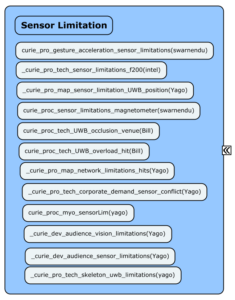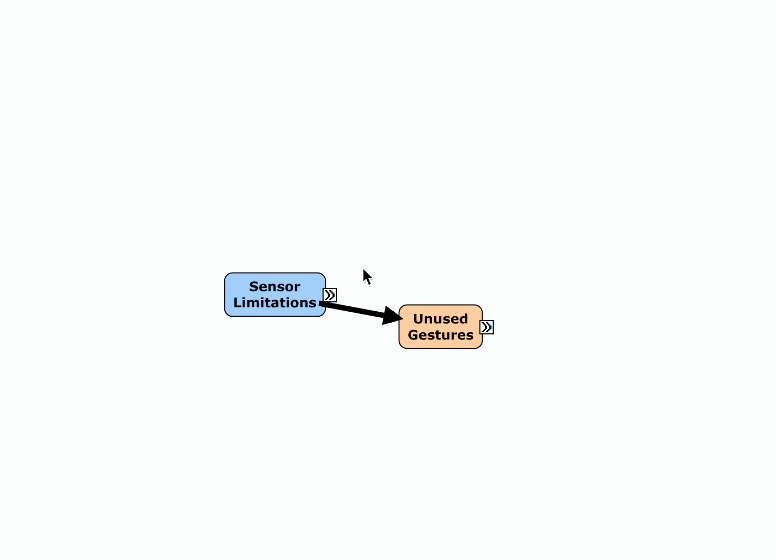Hi again! Last week we covered how Mind Maps organize your writing. We also talked about simplifying data by coding text extracted from subjects. Now it’s time to consolidate these codes into representative themes for your Conceptual Map. This reduces mountains of data to a manageable list of concepts that have a cause-and-effect relationship to each other. It’s from these relationships that you will discover fresh knowledge.
(I forgot to mention last week, I use CmapTools to make my Conceptual Maps. It’s free and the researchers behind it have tons of documentation available. Totally recommend it.)
Themes

Embedded Codes in Conceptual Map
You’ve spent hours reading and coding your collected data, and have probably uncovered some interesting concepts that represent issues, strategies, emotions, or characteristics related to your research subjects. Place these concepts- which I’ll call themes- anywhere on your map inside a text bubble. Don’t worry- they will be re-organized later as they gravitate towards each other. You may want to color the bubbles to represent categories. As aforementioned, these themes can be categorized as issues, strategies, emotions, characteristics, etc. Experiment with categories and bubble colors, there is no one particular way to do it.
For example, let us suppose that you are researching the representation of Latinos in Marvel comics. One comic book writer stated that: “publishers are pressuring writers to include more minorities in their characters.” Hey, maybe “publishers”, “writers,” “minorities,” and “characters” are popping up all the time in your interviews with writers, readers, and publishers. Great! Make each one them a theme. Also, consider categorizing “publishers” and “writers” as stakeholders, and “characters” as artwork.
Embed codes referring to the theme inside the bubble. These codes need to exist in both the word processor and in the map. That way, you can search and recall the piece of data supporting the theme- like a breadcrumb trail leading back to where you came from. Otherwise, you will forget why you created the theme and why it in turn influences other themes. Later, these pieces of data will become evidence for arguments. As you can see on the right- my theme of: “Sensor Limitation” is supported by 12 coded quotes.
Arrows
Create arrows that connect themes containing similar codes. In the example above, “publishers” would have an arrow pointing to “characters”, meaning that the former has a say in the latter. Black arrows represent positive relationships- i.e. “more of this causes more of that” and conversely; red arrows represent negative relationships- i.e. “more of this causes less of that”. If possible, connect the arrow from one embedded code to another. Again, this will help to refer to the original piece of data. Arrows can be thickened in order to represent multiple arrows.

Embedded Codes and Arrows in Conceptual Map
At this point, your Conceptual Map will consist of two things: themes and arrows. (Later we will add preposition, yay!). It may be kind of messy, especially if you are dealing with a complex issue. No worries. Move the themes around and do some housekeeping, so to speak. Conceptual Maps have to be rehashed a few time before they present clear information. As you populate and connect your themes, the interrelationships between them will reveal the dynamics of the system under examination.
To illustrate this, let’s use last week’s example from my dissertation. Below is a section of the Conceptual Map for my multimedia brainwave performance Ad Mortuos. At the bottom left, there is a theme called “Choreography.” Now if you will recall from last week, Yacov Sharir, the choreographer, stated that the technology impacted his creative choices. Therefore, I made “Hardware Improvements” affect “Choreography.” Meanwhile, I discovered that the “Venue” where the show was performing actually imposed multiple limitations on the A/V equipment and the kinds of interactions that could be performed. It made me realize how much the physical and technological context determined our creative process. This would later have implications on the tensions between the venues, artists, and decision makers.
Next week we’ll leverage all this work to make substantive arguments! I know, it was a lot of work. But man- aren’t you happy with your organization and findings?
Part 1: Tips on How to Write a Dissertation | Part 2: Mind Maps and Conceptual Maps | Part 4: Building Propositions
Subscribe
Portfolio
Since you are here, check out some of the interactive shows that I’ve created by clicking on here.

